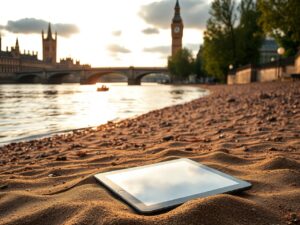In the sand dunes of a remote Western Australia beach, Tonya Illman stumbled upon a bottle.
Inside was not a genie, alas, but rather a piece of paper – and experts have since confirmed it as an authentic message from a German ship.
The discovery was made when the Perth family was driving past a beach north of Wedge Island on January 21 when, according to BBC, their car became “bogged down in the sand”.
So Illman and her friend decided to go for a walk.
The rest of the story was recalled by her husband, Kym, who, for some reason, became the family’s spokesman:
“Tonya saw a whole lot of rubbish on the ground, and thought she’d help pick up some rubbish,” Mr Illman told the BBC.
She found and picked up the bottle, thinking it would be nice for her bookshelf, he added.
Surely Kym was trying to “unbog” the car when Tonya found the bottle? I mean, he’s even holding the bottle in the picture below:

Weird.
Anyway, the male Illman continued:
Mr Illman said his wife passed the bottle “to our son’s girlfriend, who saw what she thought was a rolled-up cigarette, and tipped it out with the sand”.
“Tonya tried to untie the string around the paper, but it was rather fragile, so we took it home and put it in the oven for five minutes to dry up the moisture.
“Then we unrolled it and saw printed writing. We could not see the hand written ink at that point, but saw a printed message that asked the reader to contact the German consulate when they found the note.”
The family also noticed that the there was “a date of 12 June 1886 and the name of the ship, Paula”:
When they saw the date they thought it was “too far-fetched” to be real, Mr Illman said – but they researched the bottle online and took it to experts at the Western Australian Museum.
It turns out the note is real, and was jettisoned from Paula as part of an experiment into ocean and shipping routes by the German Naval Observatory. Dr Ross Anderson, Assistant Curator Maritime Archaeology at the WA Museum, confirmed the find’s authenticity:
“Incredibly, an archival search in Germany found Paula’s original Meteorological Journal and there was an entry for 12 June 1886 made by the captain, recording a drift bottle having been thrown overboard. The date and the coordinates correspond exactly with those on the bottle message,” Dr Anderson said.
It turns out the bottle was thrown overboard in the south-eastern Indian Ocean while the ship was travelling from Cardiff to Indonesia, and it is assumed that it only took about 12 months to wash up on the shore, where it has been buried under the sand ever since.
A better look at the bottle and the paper, below, now considered the oldest known message in a bottle ever discovered – almost 132 years after it was thrown into the sea:

And it was just the other day that this beauty was declared the oldest message in a bottle at 108 years.
The Illman family have now loaned the find to the Western Australian Museum for the next two years, where it will be on display to the public.
No doubt that was Kym’s decision.
[source:bbc]





